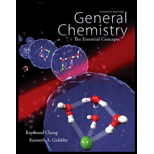
(a)
Interpretation:
The electronic transition corresponds to line B and C has to be identified.
(a)
Explanation of Solution
The given lines are corresponding to
(b)
Interpretation:
From the wavelength of line c, the wavelength of line A and B has to be calculated.
Concept Introduction:
Bohr developed a rule for quantization of energy that could be applicable to the electron of an atom in motion. By using this, he derived a formula for energy levels of electron in H-atom.
(b)
Answer to Problem 7.119SP
The wavelength of line A is
The wavelength of line B is
Explanation of Solution
The energy of line C is calculated using its wavelength as follows,
The atom in which electronic transition of
The energy change and wavelength for transitions of
Negative sign is neglected while calculating lambda
Negative sign is neglected while calculating lambda
(c)
Interpretation:
The energy required to eject an electron from
Concept Introduction:
Bohr developed a rule for quantization of energy that could be applicable to the electron of an atom in motion. By using this, he derived a formula for energy levels of electron in H-atom.
(c)
Answer to Problem 7.119SP
The energy required to eject an electron from
Explanation of Solution
The initial state is
(d)
Interpretation:
The physical significance of continuum has to be explained.
(d)
Explanation of Solution
The energy levels are closely packed when the n values become larger and it leads to continuum of lines. Electrons have been removed from atom when the continuum starts. Therefore, there will be no quantized energy levels associated with electron.
Want to see more full solutions like this?
Chapter 7 Solutions
Package: General Chemistry with Connect 2-year Access Card
 ChemistryChemistryISBN:9781305957404Author:Steven S. Zumdahl, Susan A. Zumdahl, Donald J. DeCostePublisher:Cengage Learning
ChemistryChemistryISBN:9781305957404Author:Steven S. Zumdahl, Susan A. Zumdahl, Donald J. DeCostePublisher:Cengage Learning ChemistryChemistryISBN:9781259911156Author:Raymond Chang Dr., Jason Overby ProfessorPublisher:McGraw-Hill Education
ChemistryChemistryISBN:9781259911156Author:Raymond Chang Dr., Jason Overby ProfessorPublisher:McGraw-Hill Education Principles of Instrumental AnalysisChemistryISBN:9781305577213Author:Douglas A. Skoog, F. James Holler, Stanley R. CrouchPublisher:Cengage Learning
Principles of Instrumental AnalysisChemistryISBN:9781305577213Author:Douglas A. Skoog, F. James Holler, Stanley R. CrouchPublisher:Cengage Learning Organic ChemistryChemistryISBN:9780078021558Author:Janice Gorzynski Smith Dr.Publisher:McGraw-Hill Education
Organic ChemistryChemistryISBN:9780078021558Author:Janice Gorzynski Smith Dr.Publisher:McGraw-Hill Education Chemistry: Principles and ReactionsChemistryISBN:9781305079373Author:William L. Masterton, Cecile N. HurleyPublisher:Cengage Learning
Chemistry: Principles and ReactionsChemistryISBN:9781305079373Author:William L. Masterton, Cecile N. HurleyPublisher:Cengage Learning Elementary Principles of Chemical Processes, Bind...ChemistryISBN:9781118431221Author:Richard M. Felder, Ronald W. Rousseau, Lisa G. BullardPublisher:WILEY
Elementary Principles of Chemical Processes, Bind...ChemistryISBN:9781118431221Author:Richard M. Felder, Ronald W. Rousseau, Lisa G. BullardPublisher:WILEY





